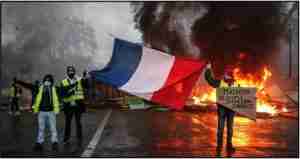The term deterrence comes from the Latin word De terre – which means to frighten. The basic idea is to frighten the potential adversary from attacking.
Deterrence is a psychological concept. It assumes that the actors are rational. Deterrence will work only when the adversary believes in the credibility of deterrence. Adversary needs to be communicated that if it prefers to attack or start war, the victory will come at the cost which is not worth paying. (In case victory comes). Thus preventing the adversary from taking action.
Deterrence is an old concept, traditionally used for conventional weapons. However now it has got associated with nuclear weapons. That is the reason number of times, deterrence is seen as an alternative approach to balance of power. The concept of deterrence is developed by Game theorists. Prominent scholars supporting deterrence include Bernard Brodie, Herman Kahn, Mearsheimer, Thomas Schelling.
1] Emergency of Theory of Deterrence
The theory of deterrence has developed with the changing postures of the superpowers and specifically USA in context of its security. It was realized that USA’s security cannot be simply dependent on conventional weapons. Conventional weapons can convert the local wars into world wars. If nuclear deterrence is developed, it can ensure that the major war is avoided. USA’s security policy during cold war was based on deterrence. The only way to avoid war with USSR was to achieve ‘MAD’ – Mutually Assured Destruction.
2] Mutually Assured Destruction
MAD can be understood as nuclear balance. It is also called as the balance of terror. MAD was dependent on the capacity of a country to convince the other country that if it starts war, it is actually starting suicide.
The idea of MAD is based on developing second strike capability. It means surviving the first attack and ability to retaliate and inflict unacceptable damage (targeting civilians). MAD requires the development of nuclear triad.
(The nuclear triad refers to a country’s ability to deliver nuclear weapons through three different platforms i.e. land-based missiles, submarine-launched missiles, and aircraft-delivered bombs. This three-pronged system ensures second-strike capability meaning a country can retaliate even after being hit by a nuclear attack. It is considered vital for maintaining credible nuclear deterrence.)
Countries can have direct deterrence or extended deterrence. e.g. Japan, South Korea are under USA’s extended deterrence.
3] Relevance of Deterrence
Two factors raise the question mark on relevance of deterrence in contemporary period. 1) The emergence of complex interdependence. And 2) The fact that main security threat comes from non-state actors, which are relatively immune to deterrence because.
Realists scholars, however argue against irrelevance of Deterrence. According to Kenneth Waltz, nuclear weapons were factor because of which cold war remained cold.
Kenneth Waltz & Mearsheimer support ‘selective proliferation’, means proliferation among western countries will add to security, the reason being are that they are democracies. On the other hand, second generation nuclear state can’t maintain security, safety & may not be accountable to public opinions.
Liberals however believe that nuclear weapons, needs to be eliminated. The urgency has increased because of the fear of proliferation into the hands of non-state actors.
Social constructivists scholar Nina Tannenwald suggest that nuclear taboo has come into existence. According to her, the main reason US could not use nuclear weapon against Vietnam was the development of taboo against the use of nuclear weapons. Hence it is not possible for countries to use nuclear weapons. Hence those countries which do not have nuclear weapons should not feel insecure rather should support the construction of norms which strengthen the nuclear taboo further.
Henry Kissinger also does not support reliance on nuclear deterrence because deterrence will apply only in case of rational actors. According to them, countries should find other means to reduce the security threats.
Though it is widely believed that the relevance of nuclear weapons have declined in post-cold war situation, yet major countries like USA, Russia, France continue to rely on nuclear deterrence in their security policy. USA coming out of ABM treaty (Anti-Ballistic Treaty), IMF (Intermediate Range Nuclear Forces) indicate the new arms race. The Nuclear Posture Review released by Trump administration in February 2018 clearly show that US continue to rely on nuclear weapons for its security as well as security of its allies.
4] Pre-emptive Nuclear Strike
A pre-emptive nuclear strike refers to a first strike attack using nuclear weapons aimed at destroying the enemy’s ability to retaliate. It is based on the anticipation of an imminent attack rather than clear aggression.
This anticipatory nature makes it highly controversial, as such an act may not receive support from the international community. Moreover, the risk of faulty or incomplete intelligence raises the danger of catastrophic miscalculation. With the development of the nuclear triad, it has become even more difficult to neutralise a country’s entire nuclear arsenal in a single strike, thereby reducing the effectiveness and credibility of pre-emptive doctrines.










I really think , you don’t need any coaching classes,, or to waist money . Just read these notes and U will get basic understanding as well as a perfect base for answer writing. I love these notes yet I’m reading after my coaching bt really these are outstanding with easy to understand language